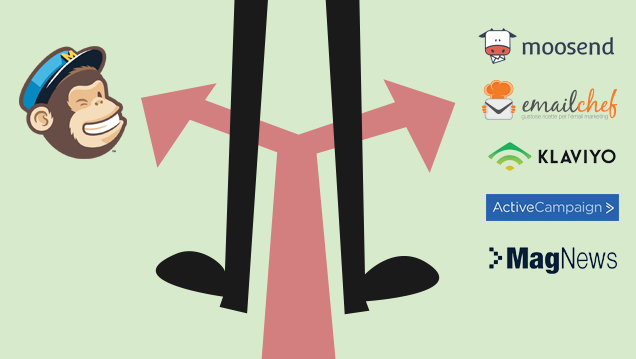Before talking about the alternatives to Mailchimp, we first have to recognize the pioneering role played by the company from Atlanta, Georgia. Mailchimp paved the way for a concept of promotional mailing that was intuitive, economical, and high quality.
Thanks to Mailchimp, the idea of email marketing is no longer the monopoly of experts or large companies with giant budgets. It’s a tool that everyone can use to communicate and promote any type of activity.
But things have changed since Mailchimp opened the market. The Mailchimp Free plan, which helped to bring millions of bloggers, small and medium businesses, online store owners and casual users to email marketing, is no more.
The new plans offered by the company are less intuitive. Their economic benefits have shrunk. The profile of their ideal customer has risen, and they’ve even divorced from Shopify. It’s almost as though Mailchimp has had a mid-life crisis.
Users are now looking for alternatives that are professional, reasonably priced, and easy to use.
You can find a tool exactly like that in our list of alternatives to Mailchimp for email marketing.
Why You Should Look for Mailchimp Alternatives
The reasons you might want an alternative to Mailchimp stem mostly from the drastic changes introduced by the company as it tried to adapt to rising competition. The result has been a service that is no longer for everyone. You should consider switching if:
You would like a personalized consulting service.
Whether your business is big or small, getting the right advice and knowing the best practices saves time and money.
You’re tired of disappointing delivery rates.
You have chosen to do email marketing in accordance with the rules and with the explicit consent of your users. You want clean and high-performing IP addresses that guarantee high delivery rates.
You are not interested in all the add-ons with which Mailchimp justified its last “revolution.”
You don’t want to build a website with Mailchimp or predict the behavior of users with algorithms, and you have no need to integrate a CRM. You want just want great email marketing. You want to receive a competitive and clear offer, with pre-determined plans and characteristics.
You want to comply with European privacy standards.
Mailchimp is based in the United States—in Atlanta, Georgia. It’s not required to comply with the European regulation GDRP. If you work with European countries, you will risk penalties if you do not abide by EU law governing the protection of personal data.
Why you might stay with Mailchimp
Despite the massive reform that Mailchimp underwent in 2018, there are still reasons to stay with it. You should stick with Mailchimp if:
You’ve come to know the Mailchimp newsletter editor, feel comfortable with it and prefer not to change.
Mailchimp’s drag and drop interface that lets you create customized newsletters has not changed. This has always been one of the best features of Mailchimp.
You appreciate the high detail of Mailchimp reporting.
Mailchimp’s very precise statistics have long been a key feature. Although competitors have now largely caught up and include integration with Google Analytics, social media, click maps, etc., if stats are your top priority you might find numbers that are as good elsewhere but you’ll struggle to find better.
You only need a small contact list.
If you have the time and focus to keep a list of no more than 2,000 contacts clean from email addresses that are unconfirmed, inaccurate and subject to bounce, then you will not incur additional costs. Bear in mind though that Mailchimp no longer makes exceptions when considering the contacts threshold of databases.
The Best Mailchimp Alternatives
Here are 5 email marketing platforms that can easily become your alternative to Mailchimp.
- eMailChef
- Moosend
- Klaviyo
- ActiveCampaign
- MagNews
eMailChef
eMailChef was built by experts with a solid email marketing background. The parent company, eDisplay, had previously developed SendBlaster, a bulk email platform, and MailStyler, software dedicated to creating newsletters with drag and drop.
Four remarkable factors make this platform stand out from the competition. b is the learning curve: figuring out how to use the tool for all the most important operations is quick and easy. The second element is the intuitive drag & drop newsletter editor which lets you assemble a responsive template (and send it) in just a few clicks. You don’t need any knowledge of HTML language.
Third, email delivery rates are high—and significantly better than those of Mailchimp. eMailChef integrates with turboSMTP, another eDisplay solution, and assigns customers a “clean” IP address. Fourth, requests for assistance are promptly and courteously answered. The languages spoken are listed on the website.
The company offers both a free 30-day trial and the possibility of a personalized demo.
Regarding the costs, eMailChef offers a wide range of plans for all budgets at fixed prices. The aim is to allow unlimited delivery, even with the cheapest plan. Main ecommerce platforms, such as WooCommerce and Magento, are integrated into eMailChef.
Where Mailchimp Beats eMailChef
eMailChef is concerned exclusively with email marketing campaigns. There is no internal CRM, no creation of landing pages, SMS messaging or integration with social networks outside of Facebook. The only CMS integration is WordPress.
Moosend
The company that developed Moosend may be not the most discussed on blogs, but the platform does the job in a working environment that is nice and clean. Everything is presented with clear explanations so that list segmentation, template building, and data analysis are all logical steps in the same cycle.
Top features include the creation of workflows for automatic emails. It takes a bit of mastering, but Moosend will let you specify the conditions that trigger a pre-written email. For example, a user might click on the main CTA of your newsletter and receive another email three days later, targeted to his or her interest.
Moosend also enables the creation of landing pages using the same, intuitive drag & drop editor used to create templates creation. The free plan which allows 1,000 contacts and unlimited sending, contains all these features. Above that threshold, prices rise in a controlled manner.
Support is provided by phone, email and chat with no additional fees. The service, as well as the whole platform, is available only in English.
Where Mailchimp Beats Moosend
Personalization and management in sign-up forms is very basic. You can customize the forms yourself, but you’ll need to change the code. Native integrations are also lacking.
Klaviyo
Klaviyo’s motto is “It was never just about email” and the company promotes itself as a tool to integrate email marketing automation and ecommerce.
Many people were disappointed by the break-up between Mailchimp and Shopify, so Klaviyo’s easy integration with Shopify is an important feature. Users can extract data from their Shopify store, for example, to automatically send abandoned cart emails to customers. The integration with Amazon’s Marketplace enables the sending of post-purchase instructions or information about an order.
Klaviyo’s user experience is personalized to the ecommerce platform you choose to integrate.
Regarding email marketing, Klaviyo includes a “standard suite” of services: a high-degree of list segmentation, integration with Facebook (only), a template visual builder, A/B test, sign-up forms creator, and SMS sending. A landing page generator is not available.
Email and chat support is available for all customers. Registration is free for up to 250 contacts with a 500 email sending limit. Beyond that threshold, prices rise sharply. The service is only available in English.
Where Mailchimp Beats Klaviyo
Klaviyo’s automations are not as user-friendly as they look, at least initially. There are some tricky set-ups and the platform is aimed at knowledgeable users. Support responsiveness is mediocre.
ActiveCampaign
Email workflows are the real gem in the crown of ActiveCampaign. Triggers and conditions can be set at multiple levels and a clear wizard allows users to master automations within a short time. Pre-made “recipes” make it easy to get started.
For email marketing, ActiveCampaign offers split testing, clear analytics, and list management in line with market standards. The template editor allows you to save custom blocks for reuse, while other team members can see any changes on the canvas.
The plans have no threshold for the number of emails. Like Mailchimp, prices are calculated by moving the lever that increases and decreases the number of contacts you plan to store in the database. You can try it for free at full potential for 14 days. It also has an integrated CRM.
Where Mailchimp Beats ActiveCampaign
Mailchimp’s statistics are much better. The visual editor also has a confusing auto-save function, and for assistance or video tutorials, the only two languages available are English or Portuguese.
MagNews
An all-in-one platform in the style of Mailchimp, MagNews offers advanced email marketing functions such as A/B testing, predictive marketing, and advanced automation, as well as Facebook profile management, SMS messaging, and push notifications. With the “Full service” plan, MagNews supports the customer from editorial planning to final reporting.
The service offers three plans with the price depending on the number of contacts you intend to upload to the database. You can request a free exploratory “tour.”
MagNews emphasizes a feature called “Web Experience.” This allows you to set rules for what users see when they browse your site. New and repeat visitors are tracked and might be shown registration forms, pop-ups, surveys and other elements that customize their user experience and increase your conversion rate.
Where Mailchimp Beats MagNews
Since MagNews was designed for companies and structured agencies, a user who wants to work autonomously is faced with an unintuitive interface. If you want to buy a plan, you will be contacted by a MagNews sales representative.
Constant Contact
Constant Contact is one of the leading options for creating websites, branded email campaigns and online stores. For the past two decades, Constant Contact has been a pioneer and renowned for providing established and robust email marketing platforms. What differentiates Constant Contact from others is the numerous features it provides to small and medium businesses.
Features such as segmentation and personalization, eCommerce integration, product recommendations, email analytics, click map and A/B testing are a few reasons marketers around the world trust this software. Even though the platform is great for email marketing, it’s not right for everyone.
You may look for alternatives to Constant Contact because using this platform is expensive when your email list grows. Alternatively, Constant Contact fails to provide actionable and enriched data on reports it generates.
Where Mailchimp beats Constant Contact
Constant Contact A/B testing limits only to subject lines, whereas Mailchimp’s A/B testing features test different versions of a single email to see how small changes impact your results.
Conclusions
Let’s be clear, Mailchimp is still a good email service provider. You can also use it perform a number of activities that go beyond email marketing. This does not come cheap.
Basic plans no longer provide users with the professional tools they need and other platforms are no more reliable, and offer better features and customer support.
The presence of many high quality products (and we could have also spoken of Envoke, GetResponse, Sendinblue, etc.) is a sign that this market has now reached maturity.
If want an excellent tool for doing email marketing, the choice is wide and the benefits clear, as a quick glance at the price sheets shows:
| Mailchimp | eMailChef | Moosend | Klaviyo | ActiveCampaign | MagNews | |
|---|---|---|---|---|---|---|
| 2K contacts | $29.99 | €10 | $10 | $60 | $39 | €74 |
| 5K contacts | $49.99 | €40 | $30 | $100 | $89 | €97 |
| 10K contacts | $74.99 | €60 | $55 | $150 | $139 | €127 |
| 50k contacts | $259 | €230 | $205 | $700 | $299 | €312 |
Starting prices for indicated volume of contacts. Tariffs per month.




